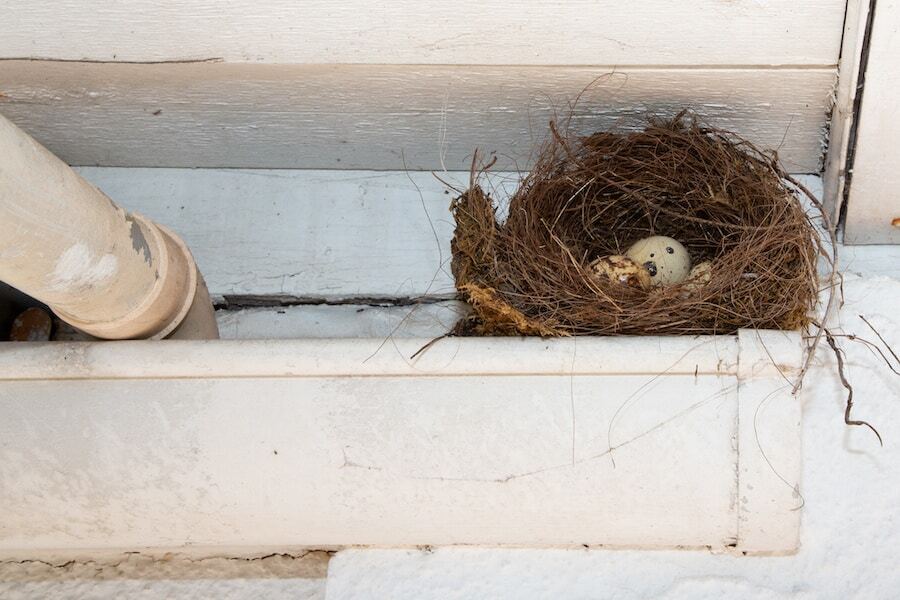Are you tired of finding bird nests where you don’t want them? Whether it’s your porch, attic, or garden, birds building nests can cause mess and damage.
You want to enjoy your space without worrying about feathers, droppings, or blocked vents. The good news? You can stop birds from nesting in your favorite spots with simple, effective steps. Keep reading to discover easy ways you can protect your home and keep birds from settling in unwanted places.

Credit: www.callnorthwest.com
Reasons Birds Build Nests
Birds build nests for many important reasons. Nests offer a safe place to lay eggs and raise baby birds. They protect eggs and chicks from weather and predators. Nests also help birds keep their young warm. Understanding why birds build nests can help prevent unwanted nesting in certain areas.
Common Nesting Habits
Birds use many materials to build nests. Twigs, leaves, grass, feathers, and mud are popular choices. Some birds build cup-shaped nests, while others create holes or platforms. Many birds return to the same nesting spot each year. Nesting often happens during spring and early summer. Birds are active and busy finding food and materials at this time.
Preferred Nesting Locations
Birds pick spots that offer safety and shelter. Trees and shrubs are common nesting places. Some birds prefer building nests on ledges or under roofs. Others choose ground locations hidden by plants. Birds may also nest inside vents, chimneys, or vents near homes. These places offer protection from predators and harsh weather.

Credit: www.npr.org
Signs Of Nest Building
Spotting the signs of nest building early can save you from bigger bird problems later. Birds don’t just appear overnight with a nest; they leave clues as they prepare. Recognizing these signs helps you act quickly and prevent unwanted nests.
Early Indicators
Birds often start by visiting your property repeatedly. You might notice them flying back and forth, carrying small items in their beaks. Listen for increased chirping or soft calls near eaves, gutters, or quiet corners of your home.
Another sign is birds gathering in one spot, especially sheltered areas like window ledges or porch roofs. You may also see them inspecting cavities or crevices, which suggests they’re scouting for a nest site. Have you ever noticed birds hanging around your yard longer than usual?
Materials Birds Use
Birds use a variety of materials to build nests, and spotting these can confirm their intentions. Look for twigs, grass blades, feathers, and even bits of string or paper scattered around your outdoor spaces. Finding small piles of these materials near roof corners or vents is a strong clue.
Some birds prefer soft substances like moss, animal fur, or leaves to line their nests. If you see these items accumulating in hidden spots, it’s a clear sign that nest building is underway. What unusual materials have you found in your yard that might have come from birds?
Preventive Measures
Stopping birds from building nests requires taking early action. Preventive measures focus on making your space less inviting. This reduces the chance that birds choose your property for nesting. Simple steps can keep birds away without harm.
Removing Nesting Materials
Clear away twigs, leaves, and other materials birds use to build nests. Check areas like gutters, eaves, and corners often. Dispose of debris quickly to prevent birds from starting a nest. Clean spots where birds have nested before to discourage return visits.
Sealing Entry Points
Close gaps and holes where birds can enter buildings or structures. Use mesh, caulk, or wood to cover openings. Make sure vents and chimneys have proper covers. Tight seals block birds from accessing sheltered areas for nesting.
Deterrent Techniques
Stopping birds from building nests requires smart deterrent techniques. These methods focus on making the area unattractive or unsafe for birds. Using various tools and approaches can keep birds away effectively.
Visual Deterrents
Birds react strongly to visual cues. Shiny objects like aluminum foil strips or old CDs reflect light. This reflection scares birds and keeps them at bay.
Fake predators, such as plastic owls or snakes, also work well. Moving these figures occasionally increases their effectiveness. Bright colors like red or orange can deter birds too. Hanging these items near nesting spots helps prevent birds from settling.
Sound-based Methods
Birds dislike sudden or loud noises. Ultrasonic devices emit sounds birds find disturbing but humans cannot hear. These devices cover a large area without disturbing people.
Recorded predator calls or distress sounds can also keep birds away. Playing these sounds intermittently avoids birds getting used to them. Noise deterrents should be used carefully to avoid disturbing neighbors.
Physical Barriers
Blocking access to preferred nesting spots is very effective. Use netting or wire mesh to cover ledges and vents. These barriers prevent birds from landing or building nests.
Installing spikes on flat surfaces stops birds from perching. Ensure spikes are bird-safe and do not harm them. Tight-fitting covers on pipes and chimneys also block entry. Regularly check and maintain barriers for best results.
Using Bird Repellents
Using bird repellents helps keep birds away from nesting areas without harm. These products create an environment that birds find unpleasant. Repellents can be natural or commercial, offering various ways to discourage birds from building nests.
Natural Repellents
Natural repellents use ingredients found in homes or gardens. Birds dislike strong smells and certain textures. Common natural repellents include:
- Vinegar spray: The smell bothers birds and keeps them away.
- Garlic or chili pepper spray: Spicy scents discourage birds from landing.
- Reflective objects: Shiny surfaces like aluminum foil or old CDs scare birds.
- Essential oils: Peppermint or eucalyptus oils act as bird deterrents.
Natural repellents are safe for pets and the environment. They need frequent reapplication, especially after rain.
Commercial Products
Commercial bird repellents come in various forms. These products are designed specifically to prevent nesting. Popular types include:
- Gel repellents: Sticky gels create uncomfortable surfaces for birds.
- Ultrasonic devices: Emit sounds birds find annoying but humans barely hear.
- Bird spikes: Physical barriers stop birds from landing on ledges.
- Sprays and granules: Chemical repellents that emit odors birds avoid.
Always follow product instructions carefully. Choose repellents safe for your area and wildlife. Commercial options often last longer than natural ones.
Safe Nest Removal
Removing bird nests safely requires careful attention to both the birds’ well-being and legal rules. You want to stop birds from nesting in unwanted areas without harming them or breaking laws. Understanding safe nest removal helps you handle the situation responsibly and effectively.
Legal Considerations
Did you know many bird species are protected by law? Removing nests during breeding season can be illegal if it disturbs eggs or chicks. Always check local wildlife regulations before taking action to avoid fines or penalties.
Some birds, like migratory species, have extra protections under federal laws. Even if a nest looks abandoned, it’s best to confirm it’s empty. Ignorance of these rules won’t protect you, so research or contact wildlife authorities if unsure.
Humane Removal Tips
Have you ever tried to remove a nest only to find active birds inside? Timing is crucial. Wait until the breeding season ends and the nest is empty before removal.
- Wear gloves to protect yourself and avoid transferring scents that might attract other birds.
- Use gentle tools like a soft brush or your hands to carefully detach the nest.
- Dispose of the nest far from your property to discourage birds from returning.
Consider placing deterrents, such as reflective tape or bird spikes, after removal. These help prevent birds from rebuilding in the same spot. Have you noticed certain areas birds prefer? Targeting those with humane methods can save you repeated efforts.
Maintaining Bird-free Spaces
Keeping areas free from bird nests requires constant care and attention. Birds choose quiet, safe places to build nests. Preventing this means staying alert and acting quickly. Maintaining bird-free spaces helps avoid damage and mess.
Regular Monitoring
Check your property often for signs of birds. Look for twigs, feathers, or droppings near ledges and corners. Early detection stops nests from forming. Watch during early spring and summer when birds build most. Use binoculars for hard-to-reach spots. Spotting nests early saves time and effort.
Ongoing Maintenance
Keep surfaces clean and clear of debris. Remove any materials birds could use for nests. Trim tree branches close to buildings. Fix holes or gaps where birds can enter. Use bird deterrents like spikes or netting on ledges. Regular upkeep discourages birds from settling in. Staying consistent is key to success.

Credit: www.callnorthwest.com
Frequently Asked Questions
How Can I Stop Birds From Nesting On My Property?
Remove nesting materials and block access to potential sites. Use bird deterrents like spikes or netting. Regularly inspect and clean areas to discourage birds from settling.
What Are Effective Bird Deterrents For Nest Prevention?
Bird spikes, netting, and reflective objects work well. Ultrasonic devices can also help, but results vary. Choose humane methods to avoid harming birds or violating laws.
Why Do Birds Choose Certain Spots For Nesting?
Birds select safe, sheltered locations with easy access to food. They prefer quiet, undisturbed areas. Understanding their preferences helps in targeting prevention efforts effectively.
When Is The Best Time To Prevent Bird Nest Building?
Prevent nesting before breeding season starts, usually early spring. Remove old nests and clean surfaces during winter. Early action reduces the chance of birds settling in.
Conclusion
Preventing birds from nesting can be a simple task. Use deterrents like shiny objects or bird spikes. Regularly check and clean potential nesting areas. These steps help keep birds away safely. Always remember to respect wildlife. It’s important to discourage nesting without causing harm.
Your home stays free from nests, and birds find safer spaces. This balance benefits everyone. Keeping birds away ensures a peaceful coexistence. With these tips, you’re well-prepared. Enjoy a nest-free environment.

